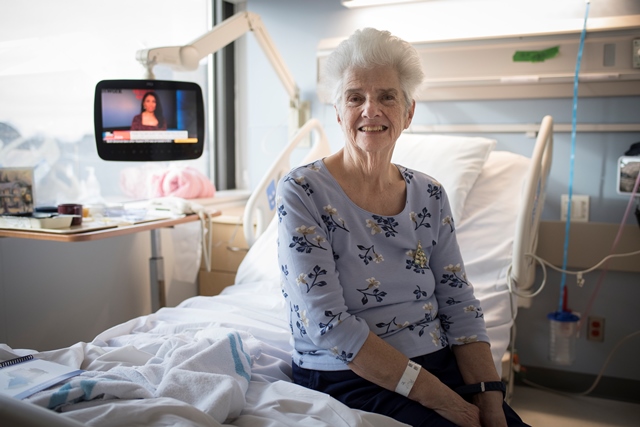By Marie Sanderson
Maureen Coleman always looked forward to her 6:00 a.m. swim every day. On one early morning, her swimming buddy noticed she looked shaky getting out of the pool. Maureen visited her family doctor and was admitted to Sunnybrook Health Sciences Centre for unsteady gait.
Maureen was in hospital about two weeks when she first heard the term ‘alternate level of care’, or ALC, patient. She no longer needed acute care hospital services but would not be able to live independently at her home.
In December 2018, Maureen was one of the first patients to move to Toronto’s newest Reactivation Care Centre near Jane Street and Highway 400. During her stay, she worked with the centre’s physiotherapy and occupational therapy staff to gain stability in her walking. “I got so much stronger and am more confident walking,” says Maureen. “And it was really good for me socially. I didn’t stop talking to the great staff and the other patients. I made some good friends.”
The Reactivation Care Centre was opened with funding from Ontario’s Ministry of Health and Long-Term Care to address high hospital occupancy and to help to alleviate hallway medicine. Patients like Maureen stay in one of the hospital’s two 30-bed units until they can move to another care facility in the community.
“The approach truly improves the safety and care of patients across the entire hospital,” says Dr. Andy Smith, President and CEO of Sunnybrook. “The Reactivation Care Centre has helped to ease the occupancy pressures we’ve been experiencing for far too long.”
Before opening beds at the Reactivation Care Centre, Sunnybrook saw very high inpatient occupancy, typically hovering from 110 to 119 per cent. To manage this level of occupancy, weekly meetings were held with clinical, operations and patient flow leads to discuss occupancy and help teams move patients in and out of the hospital as efficiently as possible. When occupancy was surging, senior leaders maintained regular contact with the Ministry of Health and Long-Term Care about the pressures.
Sunnybrook’s units at the Reactivation Care Centre have accepted 83 patients and discharged 24 (as of early February 2019). Most importantly, the innovative approach to care has created acute care capacity at Sunnybrook’s other campuses. The model has helped the hospital to provide the type of services needed by patients like Maureen, that otherwise couldn’t be offered with occupancy rates in excess of 110 per cent. Sunnybrook’s occupancy has averaged at 103 per cent since relocating patients awaiting an alternate level of care, while concurrently eliminating all hallway beds. This is significantly lower than the weeks and months preceding the opening of the centre.
Maureen describes her time at the centre as “a lot of fun – I really enjoyed having my meals in the dining room, and the rehab services got me back on my feet.” Now living at a retirement residence, Maureen gets out with friends on most days. She credits the restorative care at the Reactivation Care Centre as being key to resuming normal routines and restoring her independence.
“I’m feeling great, I’m right where I should be,” adds Maureen, as she grabs her handbag, ready for a friend to pick her up.
Marie Sanderson is a Senior Communications Advisor at Sunnybrook Health Sciences Centre.




